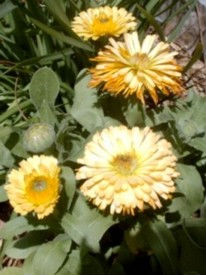Make the most of culinary herbs and spices.
All About Calendula: Herb of the Year 2008
by Sandra Bowens

You have to love a flower so associated with the sun that it was known at one time as Spousa solis, spouse of the sun. Shakespeare points to it in The Winter's Tale: "The Marigold which goes to bed with the sun, And with him rises, weeping."
This quote illustrates a fun fact about the calendula; the flowers close at dusk only to reopen again at daybreak.
Sometimes called pot marigold, calendula is not really a marigold at all but a member of the aster (Asteraceae) family. The reference to the pot came about because at one time it was widely grown in cool greenhouses for winter blooms. Why it is called a marigold is less clear.
In Chaucer's time (the late 1400's) the plants were referred to as "yellow Goldes." Monks during this same time tended the flowers in their Mary gardens because legend had it that the Biblical Mary wore them on her dress. These terms were combined into Mary-Goldes.
Long before all of this nickname business began, the early Romans noticed that the long-lasting, night-closing flowers always bloomed on the first day of the month. As a result they gave it the Latin name we know today, Calendula officinalis, calendae referring to the calendar.
Native to southern Europe, calendula is considered a cool weather annual. The entire plant is covered in fine hairs and it grows 18 to 24 inches tall, producing a multitude of ray-like flowers that measure about 3 inches across. Typically the blossoms are a yellowy-orange but they have been hybridized into a wide assortment of colors. The plant re-seeds itself with abandon although the seeds are viable for only one year.
To be named Herb of the Year by the International Herb Association and the Herb Society of America a plant must meet two of three criterions: medicinal, edible or useful for crafts. Calendula fulfills all three.
As far back as those early Romans we know that calendula has been used as a soothing salve. It has been said that a fresh flower rubbed on bee and wasp stings will provide relief from pain. Calendula should never be applied to open wounds and should be avoided altogether if one is pregnant or lactating. Those who are allergic to the large Asteraceae (formerly known as Compositae) family which includes yarrow, mums and asters should also avoid calendula.
Sloan-Kettering Cancer Center reports that recent findings show calendula ointments are more useful than traditional topical applications for the skin irritation and discomfort of radiation treatments.
The petals of calendula are edible, giving a saffron-yellow tint to dishes both sweet and savory. It makes an acceptable substitute for saffron in color only; no other spice can match the flavor of saffron.
Add the petals to baked goods or toss them into salads or soups. At one time calendula petals were essential to making a broth in the Netherlands. Such a broth would "comfort the heart and spirits."
Dried calendula leaves combined with mint are thought to make a pleasant tea.
Crafters are fond of calendula because the flowers dry so well for arranging. Individual petals should be dried without touching each other on sheets of paper in the shade. They have a tendency to stick to the screens that are often employed for drying herbs.
The flowers are more useful as a colorant than a flavoring. At one time they were used to make cheese yellow. When boiled the flowers produce a natural yellow dye.
Those who enjoy the mythic tales will find plenty of entertainment in calendula lore, as well. To quote from the book Herb Gardens of Delight by Adelma G. Simmons. "One story concerns four wood nymphs, attendants of Diana. They were all in love with the handsome Apollo, and their quarreling so displeased the goddess that she turned them into marigolds. In this guise they gazed forever on their idol. They would 'ope their golden eyes' in the morning with 'his light' and go 'to bed with the sun' at night. They became a symbol of jealousy and a warning to all maids to avoid this sin."
The other marigold we know in the garden doesn't have just one name either. Consider the Mexican, French or African varieties of the genus Tagetes. Unlike calendula, this other garden plant is native to the southwestern United States, Mexico and South America.
Here's one that's full of our favorite recipes because we wrote the book! It is also full of information, helpful hints and ideas for using herbs and spices in your kitchen.
Other articles you might enjoy:
2. Herb of the Year 2006: A Salute to Scented Geraniums
4. Herb of the Year 2005: Oregano, Family and Friends


